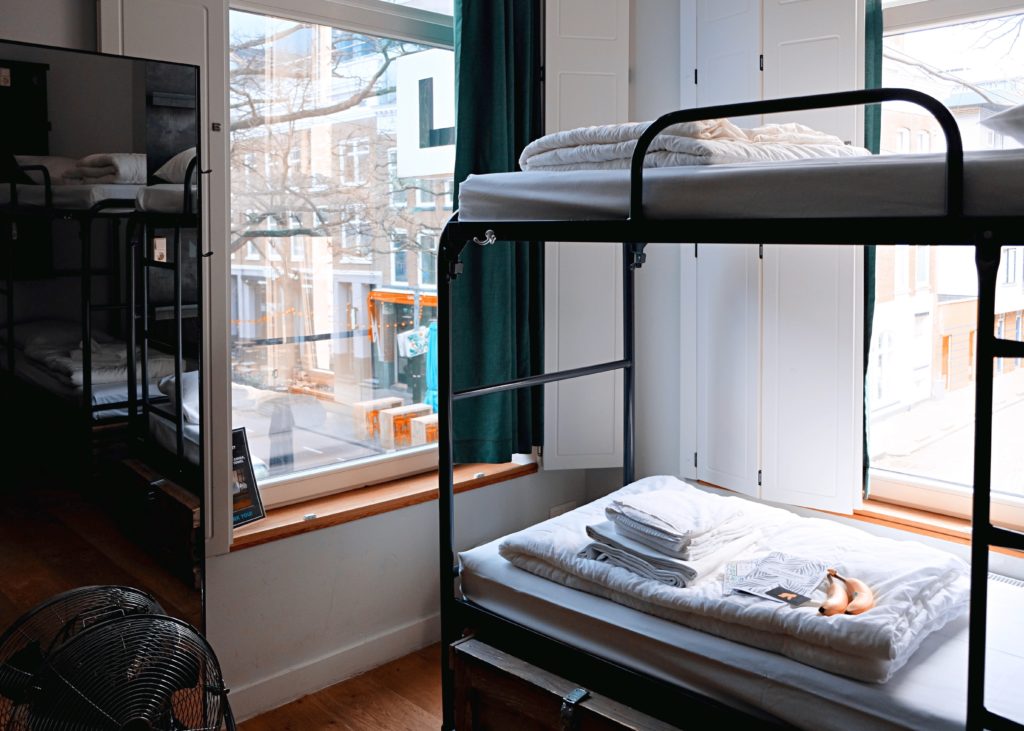A Step-By-Step Guide To Work Exchange Programs — A Nearly-Free Way To Live Abroad

It was well past 2 in the morning on a Tuesday, and I was fast asleep. I had a massive set of keys on the nightstand next to my iPhone and a second phone tucked under my pillow. A sudden ring and vibration from under my head made me leap out of bed to pull on a jacket and slippers. I grabbed the keys, tiptoed out of the room so as not to wake my roommates, and then hurtled down the four flights of stairs to arrive at the entryway of what used to be a traditional casa patio, a southern Spanish home built up around a central courtyard to create a cool outdoor space when the sweltering heat makes leaving the house impossible. I found a tipsy blonde backpacker who couldn’t have been older than 20 swaying in front of the darkened reception office. “Do you have any gluesticks?” she asked drowsily, and when I informed her that we did not, she muttered something about how no one crafts anymore and stumbled upstairs to her room. I checked the time on the phone and groaned when I saw that it was nearly three. I dragged my feet up the four flights of stairs — no elevator, of course — and collapsed back into bed while my two roommates snored on their twin mattresses. I had to be up at seven to serve the guests breakfast.
Welcome, my friends, to hostel life.
Ask anyone who has done any kind of long-term travel about ways to save money on the road, and they will likely mention some sort of work exchange. Work exchanges come in countless shapes and sizes, but the basic premise is that travelers provide a type of labor for a set number of hours, whether cleaning or farm work or, in my case, babysitting drunken college students on their gap year Eurotrip, in exchange for free housing and sometimes meals. Work exchanges are not only an excellent way to cut down on costs while traveling, they also allow you to make friends, get to know locals, add experience to your resume, and often even learn new skills in the process. The following are my best tips for finding the right work exchange for you.
How to Find a Work Exchange
Step 1: Decide your parameters.
You don’t have to go into the work exchange search knowing exactly what you want, but setting a few basic guidelines can help you narrow what is often an intimidatingly broad search. Do you have a particular city, region, or country where you want to be? Is there a specific kind of work that you want to do, or conversely, a certain type of work that you really don’t want to do? Do you need your own room, or are you willing to bunk with fellow backpackers? What kind of schedule do you want? Are you prepared to work 25 to 30 hours a week, or do you want to commit just a few hours a day so you can go chill on the beach in the afternoons? The hostel where I worked gave the more desirable daytime shifts to their small paid staff, so it was us work exchange volunteers who had to be up before sunrise to set up the breakfast bar or wake up in the middle of the night to help guests because they advertised “24/7 reception.” It worked for me, but I admit the schedule got old after a couple of months doing it, so it’s important to know your needs.
Finally, and perhaps most importantly, how long do you want to stay? Work exchanges can range from a few days to a few months or longer, and length of stay combined with your availability or readiness to start is often the deciding factor in whether you’ll be accepted by your work exchange of choice or not. If you don’t read the fine print, you may end up accidentally getting stuck in a place for much longer than you anticipated, or getting kicked out of your free bed after just a week when you wanted to stay for three.
Part of the beauty of long-term budget travel is the ability to be flexible, so be open to possibilities that you might not have thought of when you first planned your adventure. That being said, if you don’t set a handful of guidelines for your search, you’ll get overwhelmed by the sheer number and range of opportunities in the work exchange world. And if you already know exactly what you want to do, like being a guardian of the ancient corn in an eco-village or teaching soccer in Togo, then more power to you.
Step 2: The Search
There are a number of websites and platforms that you can use to find your perfect work exchange, so choose your favorite three to five and create a profile made to impress any potential “employer.” Workaway is one of the best-known websites and for good reason, since they offer to connect you with over 39,000 hosts in 178 different countries. In fact, many people simply call work exchanges of any kind “workaways,” and I’ve heard people use the term in at least seven different languages. The options are truly endless, though, so broaden your horizons and check out these options as well:
- Worldpackers is another highly popular site and happens to be where I found my work exchange at a hostel in Córdoba, Spain. They offer a number of different kinds of work exchanges, but I’ve found hostel work or related web development, tour guiding, or social media support to be especially common on the platform.
- WWOOF, which stands for Worldwide Opportunities on Organic Farms, is the workaway that your hippie neighbor from Portland did when he was in his twenties. WWOOFers, as they’re called, tend to have a reputation for being the sort of crunchy types who wear Birkenstocks and call themselves “freegans,” and the stereotypes are not entirely unfounded. That being said, WWOOF is an excellent option for anyone looking for farm work or wanting to get closer to nature, and you can do everything from cuddle lambs on a family farm to build a toolshed with your bare hands like the capable, ass-kicking adult you are.
- Unlike the other platforms that require a nominal membership fee, Hippohelp is completely free and offers a handy map interface that’s especially useful for travelers who already know where they want to go.
All of these sites are widely used, safe, and reliable, and offer a wealth of diverse options for even the choosiest traveler. In the spirit of spontaneity, however, remember that you can often create your own work exchange. It’s always important to vet for safety, of course, but I was surprised at the number of opportunities I found simply by getting to know the local community when I traveled. The world is full of potential hosts who don’t necessarily post their opportunities online, especially in communities or regions where access to the Internet is sparse or the population tends to be older and less tech-savvy. After moving to Córdoba, a relatively small city in the south of Spain, I found a number of opportunities at local mom-and-pops that would never have appeared in an online search. If you’re already traveling abroad, then take the time to patronize small businesses and get to know the locals. Not only will this result in a richer experience and better understanding of a new culture, one conversation may result in a gig at your favorite bed-and-breakfast or wine bar that allows you to stretch your dollars.
Step 3: Maximize your experience.
The perks of work exchanges vary widely by experience, so make sure you ask about them both while you’re in your search and once you arrive onsite. The hostel where I worked, for example, offered free breakfast, bicycles when the guests weren’t renting them, and most importantly for my caffeine habit and the late nights I spent at the bars before my morning shift, unlimited coffee and tea. I had a shared room, but some places offer private rooms for work exchange volunteers. Depending on the kind of work exchange you do, you might find other benefits like having all your meals covered or getting free access to paid guest activities like yoga classes or surf lessons. Sometimes you won’t even know what you can get until you ask for it, so don’t be shy.
In addition to the official benefits offered in exchange for your work, it’s possible to use, ahem, creative methods to save even more while you’re on a work exchange. First of all, most people stay in work exchanges for a few weeks to a month, which means they’re onsite long enough to accumulate basic items like umbrellas and laundry detergent but not staying long enough to use them up. Work exchange volunteers tend to be traveling for longer periods of time, so they pack light and leave extras like these behind for you to use. If you’re at a hostel, Airbnb, or bed-and-breakfast, the same is true of guests; people leave behind everything from toiletries to groceries to clothing. Once the abandoned stuff has waited in the lost-and-found for a few days, travel etiquette says that it’s fair game since you can safely assume the owners aren’t coming back. I never once paid for shampoo while I was traveling, and my best find was a Real Madrid jersey forgotten by a rowdy bachelor party that I took to be my reward for cleaning up the trail of beer cans they’d left across the hostel the night before.
The most cost-effective way to travel
More than anything, though, the best part about a work exchange is meeting other like-minded travelers who are also looking for extraordinary experiences on a budget. Despite the early morning wake-up calls and alcohol-induced antics that I had to deal with while working at a hostel, it was an overwhelmingly positive experience, largely due to the staff and the other work exchange volunteers who I met. I still cherish memories of midnight tarot readings, hikes to a monastery with stunning views, communal meals constructed from whatever we could scrounge up in the fridge, and laughing until our bellies hurt at the horrifying and hilarious behavior of our more difficult guests. Whatever work exchange experience you choose, you have the opportunity to make it life-changing — and wallet-friendly.
Sarah Doyel is a writer and health justice advocate currently based in Washington, DC. When she’s not behind her laptop, she’s running, reading, or drinking an entire pot of espresso. Read more of her work at www.sarahdoyel.com.
Image via Unsplash
Like this story? Follow The Financial Diet on Facebook, Instagram, and Twitter for daily tips and inspiration, and sign up for our email newsletter here.




